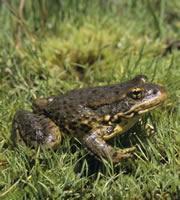 The Mountain yellow-legged frog of California is plagued by fungal infections.NHPA
The Mountain yellow-legged frog of California is plagued by fungal infections.NHPAPlanting bacteria on frogs' skin might help to save amphibians from their global decline, hints new research. The work shows that frog probiotics can help to fight off a lethal fungus.
Many populations of amphibians are plummeting, and some have already gone extinct. One of the major causes is a fungus called Batrachochytrium dendrobatidis, which lives on the skin of some frogs and salamanders.
As in humans, amphibians host a community of bacteria on their skin. So Reid Harris at James Madison University in Harrisonburg, Virginia, wondered whether the community carried by amphibians susceptible to B. dendrobatidis had lost its ability to fight off the fungus.
To test this idea, Harris and his colleagues isolated different bacteria species from the skin of a common salamander. They put the each of these species on top of some B. dendrobatidis growing in a Petri dish — and found that several of them killed off a patch of the fungus1.
Now they have shown that at least one of these bacterial species — Pedobacter cryoconitis — can help amphibians to survive. The team allowed red-backed salamanders to swim in a bath of this bacteria for two hours, and then infected them with the lethal fungus.
When tested 18 days later, the salamanders given the bacterial bath were nearly 30% more likely to have rid themselves of the fungal infection than were the untreated animals. Harris speculates that the bacterium is probably making a natural antibiotic. He reported his results at a meeting on microbes and conservation at the American Museum of Natural History in New York on 26 April.
Another bacterium, called Pseudomonas reactans, actually made the salamanders more susceptible to the fungus, perhaps because it displaced regular, infection-fighting bacteria from the skin.
Stressed-out skin
Harris suggests that environmental stresses such as climate change or pollution might change an amphibian's community of skin bacteria. The stressed animals might make less skin mucus, on which the bacteria feed, or they may make more stress hormones, which would encourage different bacterial species.
Exposing threatened amphibians to the fungus-fighting bacteria, perhaps by adding it to ponds or sites that they frequent, might help to reverse some of the population decline, Harris suggests. With few other options available, this strategy is worth pursuing, he says: "It's the only thing that's offered a glimmer of hope".
"I think it's a very promising area that needs to be pursued," says Louise Rollins-Smith, who studies amphibian immunology at Vanderbilt University in Nashville, Tennessee. "It's such an important conservation problem. Any information on a mechanism that could protect them is valuable."
Because it is unclear how long the effect of the bacteria will last, the microbes might have to be introduced again and again.
ADVERTISEMENT
The idea is akin to the probiotic food and drinks that some people swallow to try and change the community of microbes living in their guts. Some researchers are also toying with the idea of developing probiotics for human skin. Probiotics have also been used in aquaculture - in fish food or simply in the water - to try and increase yields.
Harris now plans to collaborate with colleagues in California to test whether the probiotic protects the Mountain yellow-legged frog (Rana muscosa), an endangered species that usually succumbs to the fungus.
Visit our couldsave_frogs.html">newsblog to read and post comments about this story.
